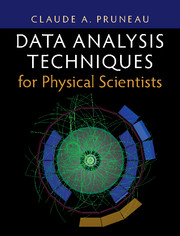Book contents
- Frontmatter
- Dedication
- Contents
- Preface
- How to Read This Book
- 1 The Scientific Method
- Part I Foundation in Probability and Statistics
- Part II Measurement Techniques
- 8 Basic Measurements
- 9 Event Reconstruction
- 10 Correlation Functions
- 11 The Multiple Facets of Correlation Functions
- 12 Data Correction Methods
- Part III Simulation Techniques
- References
- Index
10 - Correlation Functions
from Part II - Measurement Techniques
Published online by Cambridge University Press: 24 October 2017
- Frontmatter
- Dedication
- Contents
- Preface
- How to Read This Book
- 1 The Scientific Method
- Part I Foundation in Probability and Statistics
- Part II Measurement Techniques
- 8 Basic Measurements
- 9 Event Reconstruction
- 10 Correlation Functions
- 11 The Multiple Facets of Correlation Functions
- 12 Data Correction Methods
- Part III Simulation Techniques
- References
- Index
Summary
Correlation observables constitute an essential component of the toolset used by researchers in the study of the dynamics of elementary and nuclear collisions, and for measurements of the properties of the matter produced in these collisions. As such, correlation functions span a wide variety of forms and provide sensitivity to a broad range of phenomena and nuclear matter properties. Although they seemingly take many different forms, correlation functions all share a core definition and have common properties.
We introduce and motivate the notion of correlation function as an extension of the concept of covariance between two random variables in § 10.1. The concept of correlation function is, however, not limited to two variables (or fields) and can be readily developed for an arbitrary number of random variables in the form of cumulant functions, discussed in § 10.2. Cumulants play a very important role, in particular, in studies of collective properties, such as flow, of the medium produced in high-energy collisions. They are also essential for proper studies of multiparticle correlations.
Correlation functions can be broadly divided into differential and integral correlation functions. Differential correlations can be studied as a function of selected kinematical variables of two or more particles. They may be averaged over all interactions measured for a given type of collision or studied as a function of global event observables, such as the total transverse energy or the charged particle multiplicity measured in a specific kinematic range. The basic definition of inclusive correlation functions, that is, correlation averaged over all events, is introduced in § 10.2. Semi-inclusive correlations, measured as a function of global observables, are discussed in § 10.3. (Specific examples involving correlation measurements as a function of the relative emission angle and rapidity are discussed in § 11.1.1.) The concept of differential correlation functions is extended, in § 10.8, to include correlation functions weighted by particle properties. An example of such weighted correlation functions involving transverse momentum deviates is presented in § 11.1.5.
Integral correlation functions are introduced in § 10.4 in the form of factorial cumulants. They are useful, in particular, for the study of fluctuations of particle multiplicity, net charge, transverse momentum, or the relative yield of production of different particle species, discussed in Chapter 11.
- Type
- Chapter
- Information
- Data Analysis Techniques for Physical Scientists , pp. 502 - 525Publisher: Cambridge University PressPrint publication year: 2017

